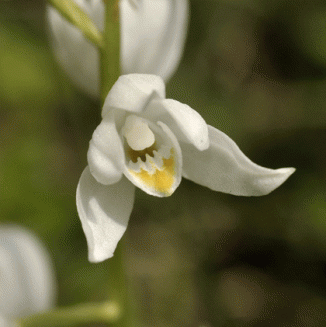Also known as Sword-leaved Helleborine, this elegant member of the family Orchidaceae is a slender stemmed plant which bears numerous strap-shaped dark green leaves, the largest at its base. On its slender 25-60 cm high stalk it carries some beautiful pure white 12mm long, bell-shaped flowers, each with a small bract. Through June and July, graceful spikes of 3-20 flowers, open and in each is an orange spot at the base of the lip. This native plant is considered to be rare here and is protected under the 2015 Flora Protection Order in the Republic of Ireland. In the UK it is classed as vulnerable.
I first found this plant in the Alpes Maretime in France in 1995 and I photographed it at that time. It was to be over a decade before I saw it, following a helpful person's directions, in Woodford, Co Galway.
If you are satisfied you have correctly identified this plant, please submit your sighting to the National Biodiversity Data Centre
This species is protected under the Flora (Protection) Order, 2015 and is classed as VULNERABLE in the Red Data List of Vascular Plants 2016 which reports 'Recent surveys sites provide a total population estimate of less than 1,000 individuals'
This beautiful plant is part of the Orchid family and as such has a distinctive way of becoming pollinated. The flower has an open mouth and on the lower lip is a 'landing pad' for bees. When the bee lands, the mouth is forced further open to accommodate the bee as he goes in search of some nectar. Then the mouth closes and the bee has to turn around and force his way back to the opening, and in doing so he gets covered in pollen. When he is free, he flies off to another flower and in repeating his search for nectar, the pollen gets spread onto the next blossom.
To learn more about our Irish orchids, I would heartily recommend a really superb book on the subject which is published by the Collins Press and entitled 'Ireland's Wild Orchids - a field guide'.
Each of our native orchids is beautifully illustrated by the gifted botanical artist, Susan Sex and is an exquisite representation of an amazing plant; Susan's illustrations are complemented by carefully-chosen words from our National Botanic Gardens orchid specialist, Brendan Sayers. Susan's illustrations of key features of our native orchids are extremely useful when trying to identify a species and Brendan's descriptions help to broaden one's understanding of this complex and intriguing subject, and lead one nearer to making a possible identification. He also contributes information on the conservation of these magnificent little plants and gives details of where they might be found. Please seek out this masterpiece from your usual bookseller or find it on Gill Books - Nature - Ireland's Wild Orchids

